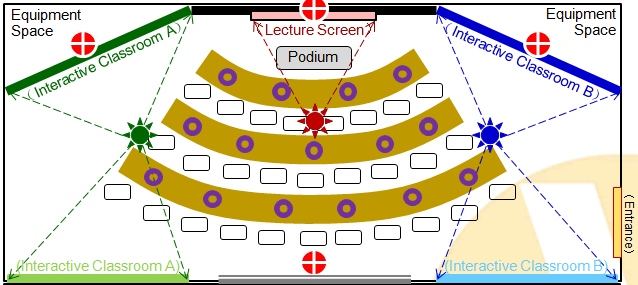The iPodia program is not a technological invention, but the realization of no-distance learning requires an innovative adaption of the present distance education technologies. A present-day iPodia interactive classroom for a university X to have joint classroom instructions with Universities A and B is shown in the figure. Compared with a typical distance education facility, where a center screen (pink) for displaying lecture slides is at the front, and a camera (IV) taking shots at the talking head of the instructor is hung at the back, a basic iPodia interactive classroom needs just three minor additions. First, live scenes of the iPodia classrooms at Universities A and B are simultaneously projected on the front screens A (green) and B (blue) for the students at University X to observe. Second, so that the Instructor in the room can also see students at Universities A and B when facing his/her own students, two smaller corresponding screens are hung at the back wall. Third, in addition to camera IV that aims at the instructor behind the podium, a set of cameras (I, II, and III) is added to take the dynamic scenes of students in the room and transmit these images to Universities A and B over the Internet. Multiple microphones (purple) are spaced out in the room so that all students can participate in live discussions with their remote classmates. Since University X is the hosting institution of this configuration, it also requires some multi-channel audio/video servers that distribute and store audio and video files.

The above classroom configuration has been implemented, and a few iPodia classes successfully conducted, among USC in Los Angeles, Peking University in Beijing, and National Taiwan University in Taipei using the existing campus-grade Internet. Except for infrequent network dropouts, no major audio nor video delayed were experienced. In the future, an integration with Telepresence, eLearning, and social networking technologies can be considered to further enhance the realism of classroom-to-classroom interaction among all students. Tele-presence technology has been used successfully in teleconferences and virtual meetings in the business world. With a modified setting to accommodate a central speaker (i.e., the class instructor), telepresence technology can greatly enhance the effectiveness of learner interactions. The static, centralized eLearning technology has been common in the current distance education programs. With a change to more dynamic, distributed and collaborative system architectures, these eLearning systems can better support the iPodia style of active and interactive learning. Lastly, social networking has been quite popular among the young generation in recent years. With adaptation to more academic usages and better integration with courseware contents, it can become a powerful aid to help students to engage in active contextual learning.